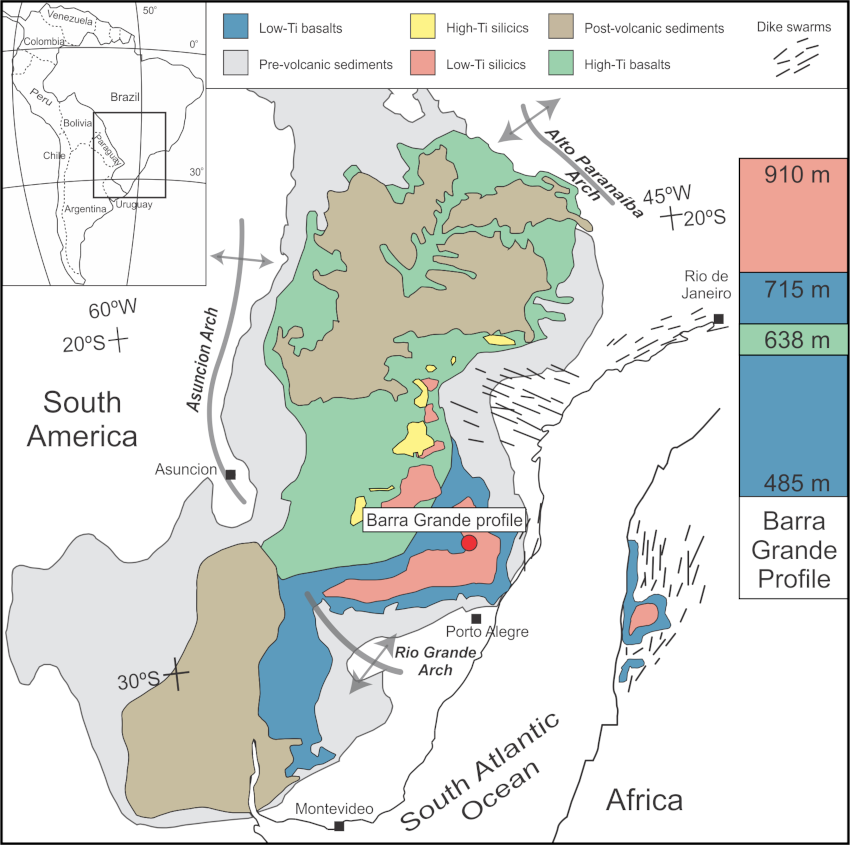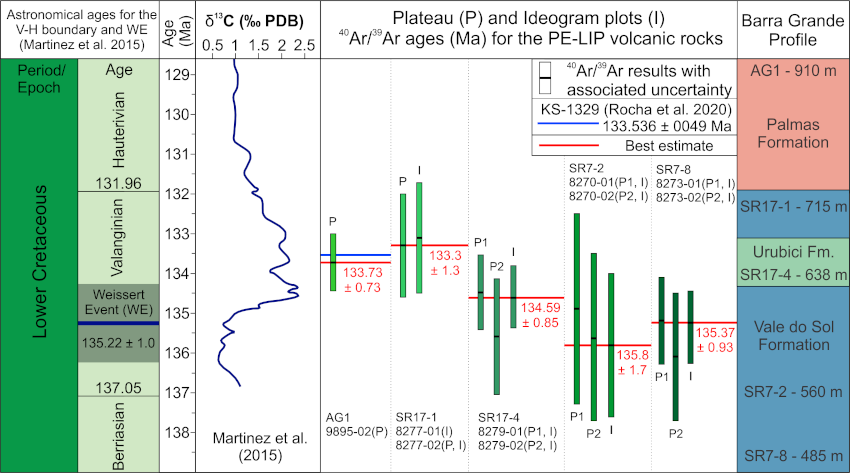October 2021 LIP of the Month
The mafic volcanic climax of the Paraná-Etendeka Large Igneous Province as the trigger of the Weissert Event
Rafael R. B. Bacha1, Breno L. Waichel2, Richard E. Ernst1, 3
1Department of Earth Sciences, Carleton University, Ottawa, Canada
2Geosciences department, Federal University of Santa Catarina, Florianopolis, Brazil
3Faculty of Geology and Geography, Tomsk State University, Russia
E-mail:
Richard.Ernst@ErnstGeosciences.com
ABSTRACT
Many Large Igneous Provinces (LIPs) cause dramatic climate change that results mass extinctions and anoxic events. Even though the Early Cretaceous Paraná–Etendeka Igneous Province has a comparable erupted volume (>1 Mkm3) to other LIPs (e.g., Deccan, Emeishan, and Siberian Traps), it remains controversial why this LIP did not contribute to a mass extinction and whether it is associated with the Weissert anoxia event. This work presents new 40Ar/39Ar dating over a 425-meter vertical stratigraphic profile (out of 1,000 m total for the Barra Grande section) that spans three formations of the PE-LIP in southern Brazil (low-Ti Vale do Sol, high-Ti Urubici, and high-Ti Palmas). Our data demonstrate that this mafic lava pile was emplaced in ca. 2.0 m.y., from ca. 135.5 Ma to ca. 133.5 Ma, and endorse the hypothesis that the basaltic and andesitic flows of the Vale do Sol Formation (peak of mafic magmatism) contributed to the Weissert Event.
Keywords: Parana-Etendeka Igneous Province; Weissert Event; Ar-Ar geochronology; Valanginian
Extracted and revised from: Bacha, R.R.B.; Waichel, B.L., Ernst, R.E. (2021) The mafic volcanic climax of the Paraná-Etendeka Large Igneous Province as the trigger of the Weissert Event. Terra Nova, (on-line) https://doi.org/10.1111/ter.12558
GEOLOGY AND GEOCHRONOLOGY
The PE-LIP (Parana-Etendeka Large Igneous Province) was formed from Valanginian to Hauterivian Early Cretaceous age and is composed of mostly tholeiitic rocks exposed as large subaerial lava flows, radiating and circumferential dike swarms, and intrusive igneous rocks. Low-Ti igneous rocks are predominant in the south, migrating to high-Ti towards north (Bellieni et al., 1984b, Buchan and Ernst, 2019).

Figure 1. Geological map of the PE-LIP in South America and correlation with African counterpart, showing location of the Barra Grande profile and its stratigraphic extent.
This work presents step-heating 40Ar/39Ar data from three formations of the PE-LIP (Figure 2): (1) the low-Ti basaltic VSF (samples SR7-8, SR7-2, and SR17-1); (2) the low-Ti acidic PF (sample AG1); and (3) the high-Ti basaltic Urubici magma type (sample SR17-4).

Figure 2. New geochronological data for the Barra Grande profile. Left: comparison with the Lower Cretaceous time scale and Valanginian-Hauterivian boundary, Weissert Event (horizontal dark blue bar), and carbon isotope excursion data (δ13C) used to interpret the beginning of the WE isotopic excursion date (Martinez et al., 2015). Center: plot of plateau and isochron Ar-Ar step-heating data from the Barra Grande profile in the PE-LIP, including error uncertainties. Right: Barra Grande profile with stratigraphic position of the dated samples, and values for the elevation above sea level.
Timing and Duration of the Magmatism of the PE-LIP in Southern Brazil
It is considered unlikely the hypothesis that the entire PE-LIP was formed within c.a. 1.2 m.y. when the Barra Grande profile alone shows robust Ar-Ar results spanning at least 2 m.y. based on each sample’s best estimate for 425 m of the preserved Barra Grande lava pile, without considering the older TF volcanics below and younger overlaying eroded volcanic rocks which would suggest a ca. 1,000 m original thickness for the Barra Grande lava pile. When compared to other well-studied LIPs, the PE-LIP emplacement is likely longer than the <2 m.y. Deccan Traps (Schoene et al., 2019) and Siberian Traps (Burgess and Bowring, 2015), and shorter than the two-pulse North Atlantic LIP and the much longer Keweenawan LIP (Ernst, 2014; Woodruff et al. 2020, and references therein).
Link between the PE-LIP Mafic Magmatism and the Weissert Event
In the southern Brazil the low-Ti VSF is the thickest basic volcanic unit (up to 500 m), is composed of rubbly pahoehoe flows with a minimum estimated volume of ca 15,000 km3 (Rossetti, 2018). The VSF covers the 250-m thick compound pahoehoe flows of the TF and represents the climax of the basic volcanism in this area. The new ages obtained for the basal samples of the VSF (SR7-8 135.37 ± 0.93 Ma and SR7-2 135.8 ± 1.7 Ma) are older than the most reliable previously published data and statistically indistinguishable from the 135.22 ± 1.0 Ma astronomical age for the beginning of the WE (Martinez et al., 2015), therefore supporting that the volcanism onset of the VSF may triggered the WE.
CONCLUSIONS
The most recent geochronological review indicates that the Weissert Event began at 135.22 ± 1.0 Ma. These novel Ar-Ar dating of 5 samples with strict stratigraphic control indicates that the lowermost volcanic unit in the Barra Grande section of the Vale do Sol Formation (VSF) has an age of ca. 135.5 Ma, indicating age overlap with WE and suggesting that the PE-LIP triggered the anoxic event. Specifically, this age is based on samples SR7-8 (485 m a.s.l., 135.37 Ma), and SR7-2 (560 m a.s.l., 135.8 Ma) which are our most robust 40Ar/39Ar results. Our data also support that the 425-meter thick Barra Grande profile spanned ca 2.0 m.y. interval (135.5-133.5 Ma) based on the VSF ages of 135.37 and 135.8 Ma and the age for the Urubici high-Ti (first high-Ti appearance on the south portion) of 134.59 ± 0.85 Ma. Stratigraphically younger portions of volcanism are present in the northern PE-LIP and therefore the total duration of the PE-LIP is >2.0 Ma, and likely spans the entire 135-131 Ma timing of the Weissert Event (Martinez et al., 2015).
REFERENCES
Bellieni, G., Comin-Chiarmonti, P., Marques, L.S., Melfi, A.J., Piccirillo, E.M., Nardy, A.J.R. and Roisenberg, A., 1984b. High- and Low-Ti flood basalts from the Paraná plateau (Brazil): Petrogenetic and geochemical aspects bearing on their mantle origin. Neues Jahrbuch fu¨r Mineralogie - Abhandlungen, 150, 273-306.
Buchan, K.L. and Ernst, R.E., 2019. Giant Circumferential Dyke Swarms: Catalogue and Characteristics. In: Dyke Swarms of the World: A Modern Perspective (R.E. Ernst, P. Peng and E.K. Srivastava, eds.) Springer Geology, Singapore.
Burgess, S. D., & Bowring, S. A., 2015. High-precision geochronology confirms voluminous magmatism before, during, and after Earth’s most severe extinction. Science Advances, 1(7), 1–14.
Ernst, R.E., 2014. Large Igneous Provinces. Cambridge University Press, Cambridge.
Martinez, M., Deconinck, J.F., Pellenard, P., Riquier, L., Company, M., Reboulet, S. and Moiroud, M., 2015. Astrochronology of the Valanginian-Hauterivian Stages (Early Cretaceous): Chronological relationships between the Paraná-Etendeka large igneous province and the Weissert and the Faraonic events. Global and Planetary Change, 131, 158-173.
Rossetti, L., Lima, E.F., Waichel, B.L., Hole, M.J., Simões, M.S. and Scherer, C.M., 2018. Lithostratigraphy and volcanology of the Serra Geral Group, Paraná-Etendeka Igneous Province in Southern Brazil: Towards a formal stratigraphic framework. J. Volcanol. Geotherm. Res., 355, 98-114.
Schoene, B., Eddy, M. P., Samperton, K. M., Keller, C. B., Keller, G., Adatte, T., & Khadri, S. F. R., 2019. U-Pb constraints on pulsed eruption of the Deccan Traps across the end-Cretaceous mass extinction. Science, 363, 862–866.
Woodruff, L.G., Schulz, K.J., Nicholson, S.W., & Dicken, C.L., 2020. Mineral deposits of the Mesoproterozoic Midcontinent Rift System in the Lake Superior region – Metallogeny of the prolifically mineralized Keweenawan LIP. Ore Geol. Rev., 126, 103716.
